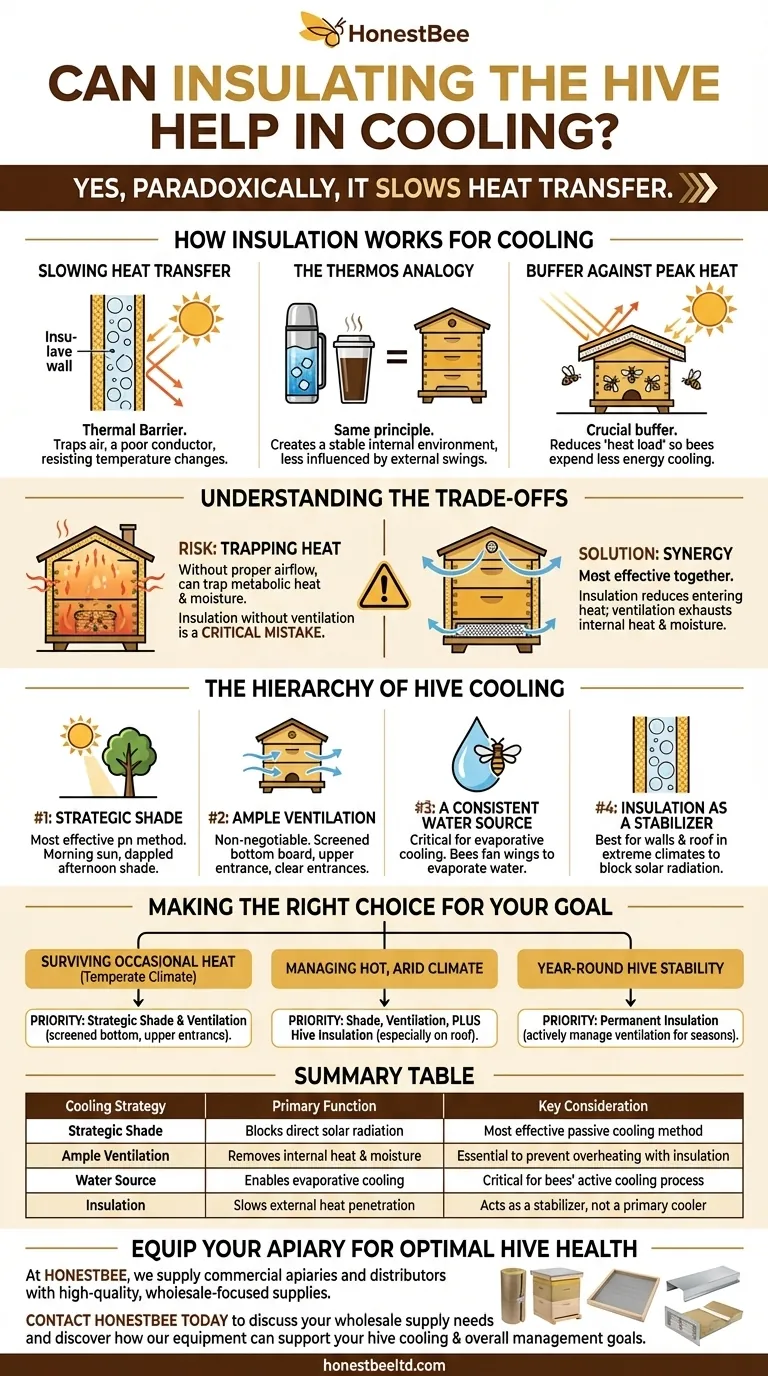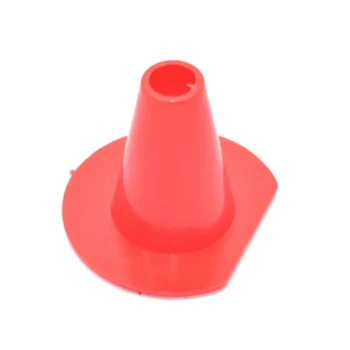Yes, paradoxically, insulation can help cool a hive. While its primary role is to protect bees from winter cold, the same physical principle—slowing heat transfer—also helps buffer the colony from extreme summer heat. Insulation works by reducing the rate at which the sun’s intense heat penetrates the hive walls, giving the bees a better chance to manage their internal temperature.
The core principle to understand is that insulation does not create cold; it simply slows the movement of heat. For a beehive, this means it slows heat from getting in on a hot day just as it slows heat from getting out on a cold day. However, it is a supportive tool, not a replacement for the primary cooling methods of shade and ventilation.
How Insulation Actually Works for Cooling
It’s About Slowing Heat Transfer
Insulation’s function is to provide a thermal barrier. It works by trapping pockets of air, which is a poor conductor of heat.
This barrier resists temperature changes in both directions. It doesn’t generate cold, but it drastically slows down the process of the outside environment heating the hive's interior.
The Thermos Analogy
Think of a high-quality thermos. It keeps hot coffee hot for hours, but it will also keep iced water cold on a hot day. The insulation in the thermos walls performs the exact same function as insulation on a hive.
It creates a more stable internal environment that is less influenced by dramatic external temperature swings.
A Buffer Against Peak Heat
The sun beating down on a dark hive roof can raise the surface temperature dramatically. A layer of insulation, especially under the roof, acts as a crucial buffer.
This buffer reduces the "heat load" on the colony, meaning the bees expend less energy and water trying to cool a space that is rapidly being heated by the sun.
Understanding the Trade-offs
Insulation Can Trap Heat
The most significant risk is that insulation can be too effective if not paired with proper airflow. A bee cluster generates its own metabolic heat, and a poorly ventilated, insulated hive can trap this heat and moisture.
This can turn the hive into an oven, making the overheating problem worse. Insulation without ventilation is a critical mistake.
The Synergy of Insulation and Ventilation
The most effective systems use both insulation and ventilation together. Insulation reduces the amount of external heat entering the hive, while ventilation allows the bees to exhaust the heat and moisture they generate internally.
A screened bottom board or an upper entrance provides a "chimney effect" for natural convection, which is essential for removing hot, humid air.
The Hierarchy of Hive Cooling
Effective cooling is not about a single solution but a combination of strategies. You should prioritize them in order of impact.
#1: Strategic Shade
Shade is the single most effective and passive way to keep a hive cool. The ideal location provides direct morning sun to encourage foraging but offers dappled or full shade during the intense heat of the afternoon (from 1 PM onwards).
#2: Ample Ventilation
Proper airflow is non-negotiable. This includes using a screened bottom board, providing an upper entrance or ventilation port, and ensuring entrances are not obstructed by grass or debris.
#3: A Consistent Water Source
Bees are masters of evaporative cooling. They collect water and spread it on the surface of the comb, then fan their wings to evaporate it, which actively cools the hive. A reliable water source nearby is critical for this process.
#4: Insulation as a Stabilizer
Finally, insulation serves as a stabilizer, especially in climates with extreme temperature swings. It is best used on the hive walls and, most importantly, under the main cover to block direct solar radiation.
Making the Right Choice for Your Goal
Before adding insulation, clarify your primary objective.
- If your primary focus is surviving occasional heat waves in a temperate climate: Prioritize creating afternoon shade and ensuring you have a screened bottom board and an upper entrance for ventilation.
- If your primary focus is managing a hive in a hot, arid climate: Combine shade and ventilation with hive insulation (especially on the roof) to buffer the colony from relentless daytime solar gain.
- If your primary focus is year-round hive stability: Using insulation permanently can reduce stress from both summer heat and winter cold, but only if you actively manage ventilation to match the season.
Ultimately, your goal is to help the bees maintain a stable microclimate with minimal stress.
Summary Table:
| Cooling Strategy | Primary Function | Key Consideration |
|---|---|---|
| Strategic Shade | Blocks direct solar radiation | Most effective passive cooling method |
| Ample Ventilation | Removes internal heat and moisture | Essential to prevent overheating with insulation |
| Water Source | Enables evaporative cooling | Critical for bees' active cooling process |
| Insulation | Slows external heat penetration | Acts as a stabilizer, not a primary cooler |
Equip Your Apiary for Optimal Hive Health
Managing hive temperature is crucial for colony success. At HONESTBEE, we supply commercial apiaries and beekeeping equipment distributors with the high-quality, wholesale-focused supplies needed to implement these strategies effectively.
From insulated hive wraps to screened bottom boards and ventilation components, our products are designed to help your bees thrive in any climate. Let us help you build a more resilient and productive operation.
Contact HONESTBEE today to discuss your wholesale supply needs and discover how our equipment can support your hive cooling and overall management goals.
Visual Guide

Related Products
- Professional Insulated Winter Hive Wrap for Beekeeping
- Professional Galvanized Hive Strap with Secure Locking Buckle for Beekeeping
- Langstroth Screen Bottom Board for Beekeeping Wholesale
- Professional Plastic Queen Excluder for Modern Beekeeping
- Wooden Bee Brush with Double-Row Horsehair Bristles
People Also Ask
- What are the durability features of Bee Blankets? Built to Last in Demanding Apiary Conditions
- What factors ensure bees stay warm and healthy during winter? Master the 3 Keys to Hive Survival
- Why is insulation important for hives during winter? Ensure Your Bees Survive and Thrive
- What are the benefits of insulated beehives in cold weather? Boost Winter Survival & Spring Productivity
- What is the advantage of an insulated outer cover? Boost Winter Survival & Spring Buildup



















